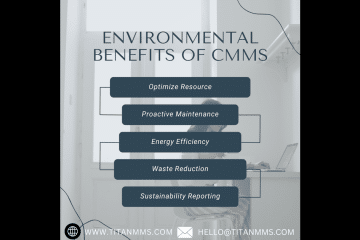Introduction
In today’s fast-paced industrial landscape, the integration of data analytics and reporting in Computerized Maintenance Management Systems (CMMS) has become crucial. With the ability to harness vast amounts of data, businesses can make informed decisions, optimize maintenance processes, and enhance overall operational efficiency.
Understanding CMMS
What is a CMMS?
A CMMS, or Computerized Maintenance Management System, is a software solution designed to streamline maintenance management. It helps organizations plan, track, and optimize all aspects of maintenance operations from scheduling tasks to managing assets.
Key Features of CMMS
CMMS platforms typically offer features such as work order management, asset tracking, inventory control, and preventive maintenance scheduling. These tools are essential for maintaining equipment reliability and reducing downtime.
Benefits of Using a CMMS
Implementing a CMMS brings numerous benefits including improved asset performance, reduced maintenance costs, enhanced compliance with regulations, and better resource allocation. It also provides a centralized repository of maintenance information that is easily accessible and manageable.
Role of Data Analytics in CMMS
Definition of Data Analytics
Data analytics involves examining raw data to draw meaningful insights and conclusions. In the context of CMMS, it refers to analyzing maintenance-related data to improve decision-making and operational efficiency.
How Data Analytics is Integrated into CMMS
Modern CMMS platforms come equipped with data analytics capabilities. They collect and analyze data from various sources such as sensors, manual inputs, and historical records, enabling organizations to identify trends, predict failures, and optimize maintenance schedules.
Importance of Data-Driven Decision-Making
Data-driven decision-making ensures that maintenance strategies are based on factual data rather than intuition. This approach leads to more accurate predictions, efficient resource utilization, and overall better performance of maintenance operations.
Types of Data in CMMS
Maintenance Data
Maintenance data includes information about all maintenance activities such as inspections, repairs, and replacements. This data helps in tracking the health and performance of equipment over time.
Asset Data
Asset data comprises details about all physical assets within an organization. This includes their location, condition, maintenance history, and lifecycle information.
Inventory Data
Inventory data involves tracking the availability, usage, and costs of spare parts and materials required for maintenance tasks. Effective inventory management is crucial for minimizing downtime and ensuring the availability of critical components.
Work Order Data
Work order data encompasses all the information related to maintenance work orders, including the tasks performed, personnel involved, time taken, and any issues encountered.
Collecting Data in CMMS
Methods of Data Collection
Data can be collected through various methods such as manual entries by maintenance staff, automated sensors, IoT devices, and integration with other systems like ERP and EAM.
Best Practices for Accurate Data Collection
To ensure accurate data collection, it is important to standardize data entry processes, regularly update data, and employ automated systems wherever possible. Training staff on the importance of accurate data entry also plays a significant role.
Common Challenges and Solutions
Common challenges in data collection include data entry errors, inconsistent data formats, and lack of integration between systems. Solutions involve implementing robust data validation checks, standardizing data formats, and ensuring seamless integration between different systems.
Analyzing Data in CMMS
Tools and Techniques for Data Analysis
Various tools and techniques can be used for data analysis in CMMS, such as statistical analysis, predictive modeling, and machine learning algorithms. These tools help in uncovering patterns, predicting failures, and optimizing maintenance schedules.
Key Metrics and KPIs to Track
Important metrics and KPIs to track include Mean Time Between Failures (MTBF), Mean Time to Repair (MTTR), equipment downtime, maintenance costs, and work order completion rates. Monitoring these KPIs helps in assessing the effectiveness of maintenance strategies.
Case Studies of Successful Data Analysis
Many organizations have successfully leveraged data analytics in their CMMS to achieve significant improvements. For example, a manufacturing plant might reduce equipment downtime by 20% through predictive maintenance, or a utility company might cut maintenance costs by 15% by optimizing inventory levels.
Reporting in CMMS
Importance of Reporting
Reporting is essential for translating data into actionable insights. It enables maintenance managers to make informed decisions, track performance, and communicate results to stakeholders.
Types of Reports
CMMS platforms offer various types of reports such as maintenance activity reports, asset performance reports, inventory usage reports, and compliance reports. These reports provide a comprehensive view of maintenance operations.
Customizable Reporting Options
Many CMMS solutions allow for customizable reporting options, enabling users to tailor reports to their specific needs. This flexibility ensures that the right information is presented in the most useful format.
Automated Reporting
Benefits of Automated Reporting
Automated reporting saves time and reduces the likelihood of errors. It ensures that reports are generated consistently and on schedule, providing timely insights for decision-making.
Setting Up Automated Reports
Setting up automated reports involves configuring the CMMS to generate reports based on predefined schedules or triggers. Users can specify the data to be included and the format of the report.
Examples of Automated Report Usage
Examples of automated report usage include daily maintenance activity summaries, weekly asset performance reviews, and monthly inventory usage reports. These automated reports help in keeping track of key metrics without manual intervention.
Improving Maintenance Strategies with Data Analytics
Predictive Maintenance
Predictive maintenance uses data analytics to predict equipment failures before they occur. By analyzing patterns and trends, organizations can schedule maintenance activities at the most opportune times, reducing unplanned downtime.
Preventive Maintenance
Preventive maintenance involves performing regular maintenance tasks based on predefined schedules. Data analytics helps in optimizing these schedules by identifying the most effective maintenance intervals.
Condition-Based Maintenance
Condition-based maintenance relies on real-time data to assess the condition of equipment. Maintenance activities are performed based on the actual condition of the equipment rather than on a fixed schedule, leading to more efficient use of resources.
Enhancing Asset Management through Data
Tracking Asset Performance
Data analytics enables organizations to track the performance of assets in real-time. This helps in identifying underperforming assets and taking corrective actions to improve their efficiency.
Optimizing Asset Lifecycle
By analyzing data related to asset usage and maintenance, organizations can optimize the lifecycle of their assets. This includes making informed decisions about repairs, replacements, and retirements.
Reducing Asset Downtime
Reducing asset downtime is a key goal of effective asset management. Data analytics helps in identifying the root causes of downtime and implementing strategies to minimize it.
Inventory Management with Data Insights
Monitoring Inventory Levels
Data analytics provides insights into inventory levels, helping organizations maintain optimal stock levels. This ensures that critical spares are always available when needed.
Reducing Inventory Costs
By analyzing inventory data, organizations can identify excess stock and reduce carrying costs. This leads to significant cost savings without compromising on maintenance efficiency.
Ensuring Availability of Critical Spares
Ensuring the availability of critical spares is essential for minimizing equipment downtime. Data analytics helps in forecasting demand and managing inventory effectively.
Work Order Management Using Data
Prioritizing Work Orders
Data analytics helps in prioritizing work orders based on factors such as equipment criticality, failure rates, and available resources. This ensures that the most important tasks are addressed first.
Tracking Work Order Completion
Tracking the completion of work orders is crucial for assessing the efficiency of maintenance operations. Data analytics provides insights into work order completion rates and helps in identifying bottlenecks.
Improving Response Times
Improving response times to maintenance issues is essential for minimizing downtime. Data analytics helps in identifying areas where response times can be improved and implementing corrective actions.
Challenges in Data Analytics and Reporting
Data Quality Issues
Data quality issues such as incomplete, inaccurate, or inconsistent data can hinder effective analysis. Ensuring data integrity through validation checks and regular audits is essential.
Integration with Other Systems
Integrating CMMS with other systems such as ERP and EAM can be challenging. Seamless integration is necessary for comprehensive data analysis and reporting.
Training and Skill Requirements
Effective data analytics requires skilled personnel who can interpret data and generate actionable insights. Investing in training and development is crucial for maximizing the benefits of data analytics.
Future Trends in CMMS Data Analytics
AI and Machine Learning
Artificial Intelligence (AI) and machine learning are set to revolutionize CMMS data analytics. These technologies can analyze vast amounts of data and provide predictive insights that were previously unattainable.
Internet of Things (IoT) Integration
The integration of IoT devices with CMMS will enable real-time data collection and analysis. This will enhance predictive maintenance capabilities and improve overall operational efficiency.
Real-Time Data Analytics
Real-time data analytics will allow organizations to make immediate decisions based on the most current information. This will lead to more dynamic and responsive maintenance strategies.
Conclusion
Data analytics and reporting in CMMS are transforming maintenance management. By leveraging data, organizations can optimize their maintenance strategies, enhance asset performance, and achieve significant cost savings. As technology continues to evolve, the future of CMMS data analytics promises even greater advancements.
FAQs
Q1- What is a CMMS and how does it work?
A) A CMMS is a software solution that helps organizations manage their maintenance operations. It works by tracking maintenance activities, managing assets, controlling inventory, and scheduling tasks to improve efficiency and reduce downtime.
Q2- How can data analytics improve maintenance strategies?
A) Data analytics can improve maintenance strategies by providing insights into equipment performance, predicting failures, optimizing maintenance schedules, and reducing unplanned downtime. It enables data-driven decision-making that enhances overall maintenance efficiency.
Q3- What types of reports can be generated in a CMMS?
A) A CMMS can generate various types of reports including maintenance activity reports, asset performance reports, inventory usage reports, and compliance reports. These reports provide a comprehensive view of maintenance operations and help in making informed decisions.
Q4- What are the challenges of implementing data analytics in CMMS?
A) Challenges of implementing data analytics in CMMS include data quality issues, integration with other systems, and the need for skilled personnel. Addressing these challenges involves ensuring data integrity, seamless integration, and investing in training and development.
How will future trends shape CMMS data analytics?
Future trends such as AI, machine learning, IoT integration, and real-time data analytics will significantly enhance CMMS capabilities. These technologies will provide deeper insights, more accurate predictions, and more efficient maintenance strategies




0 Comments